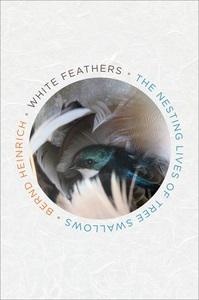
 Bernd Heinrich (Mind of the Raven, Life Everlasting) is a celebrated naturalist and birdwatcher. In White Feathers: The Nesting Lives of Tree Swallows, he turns his attention to a little-understood feature of a much-studied species. Tree swallows are considered a "model" bird for research, but Heinrich finds nothing in the literature to explain the phenomenon that intrigues him: Why does the pair nesting outside his door line its nest with white feathers--the hardest kind to find in the remote Maine woods?
Bernd Heinrich (Mind of the Raven, Life Everlasting) is a celebrated naturalist and birdwatcher. In White Feathers: The Nesting Lives of Tree Swallows, he turns his attention to a little-understood feature of a much-studied species. Tree swallows are considered a "model" bird for research, but Heinrich finds nothing in the literature to explain the phenomenon that intrigues him: Why does the pair nesting outside his door line its nest with white feathers--the hardest kind to find in the remote Maine woods?
Over eight summers, Heinrich observes the tree swallows that come to nest outside his cabin, where he installs nest boxes for their use. He is up by dawn each morning in season, and often earlier, at three and four a.m., to track them in the dark by sound. He takes meticulous notes on many dozens of matings, landings and takeoffs, calls and nest visits. He daubs red paint on one female to keep her identity straight, and designs numerous small-scale experiments, for example offering black and white feathers on both black and white tarps and on the plain ground, to test for color preference versus simple contrast against background. Dozens of other bird species are mentioned along the way, but in these pages, Heinrich's attention is singularly tied to a handful of individual tree swallows: blue-green males and their more drab female companions, and the quickly fledged young they rear in the clearing outside Heinrich's cabin.
White Feathers is an unusual book, in that its focus is so complete. Filled with extremely detailed notes, it will be of greatest interest to other tree swallow enthusiasts. But Heinrich's occasional, lovely comment on the art of observation will charm anyone concerned with paying close attention. "My patience was tested by the now constant assault of black flies, which started soon after sunrise. But I could not stop. Many dots are needed before you can connect them into a picture of what it is like to be a tree swallow"; Heinrich is obviously passionately driven to see that picture. "Expecting constantly scintillating observations is the best guarantee of tedium. To be successful as a naturalist requires the mindset of a beggar, eager and thankful for every crumb of information."
Intimately involved with the tree swallows, Heinrich nonetheless does not anthropomorphize, but explains what he sees by way of evolution and other natural forces. In the end, he offers theories as to the titular question of white feathers, but he illuminates many other nuances of tree swallow life as well along the way. The joy of White Feathers is in its careful concentration, its patience and attention to detail and in the obvious joy its author takes in the nesting lives of an unassuming bird. --Julia Kastner, librarian and blogger at pagesofjulia
Shelf Talker: A seasoned naturalist turns his thorough gaze upon a much-studied bird and makes fresh observations in this quietly lovely account.

